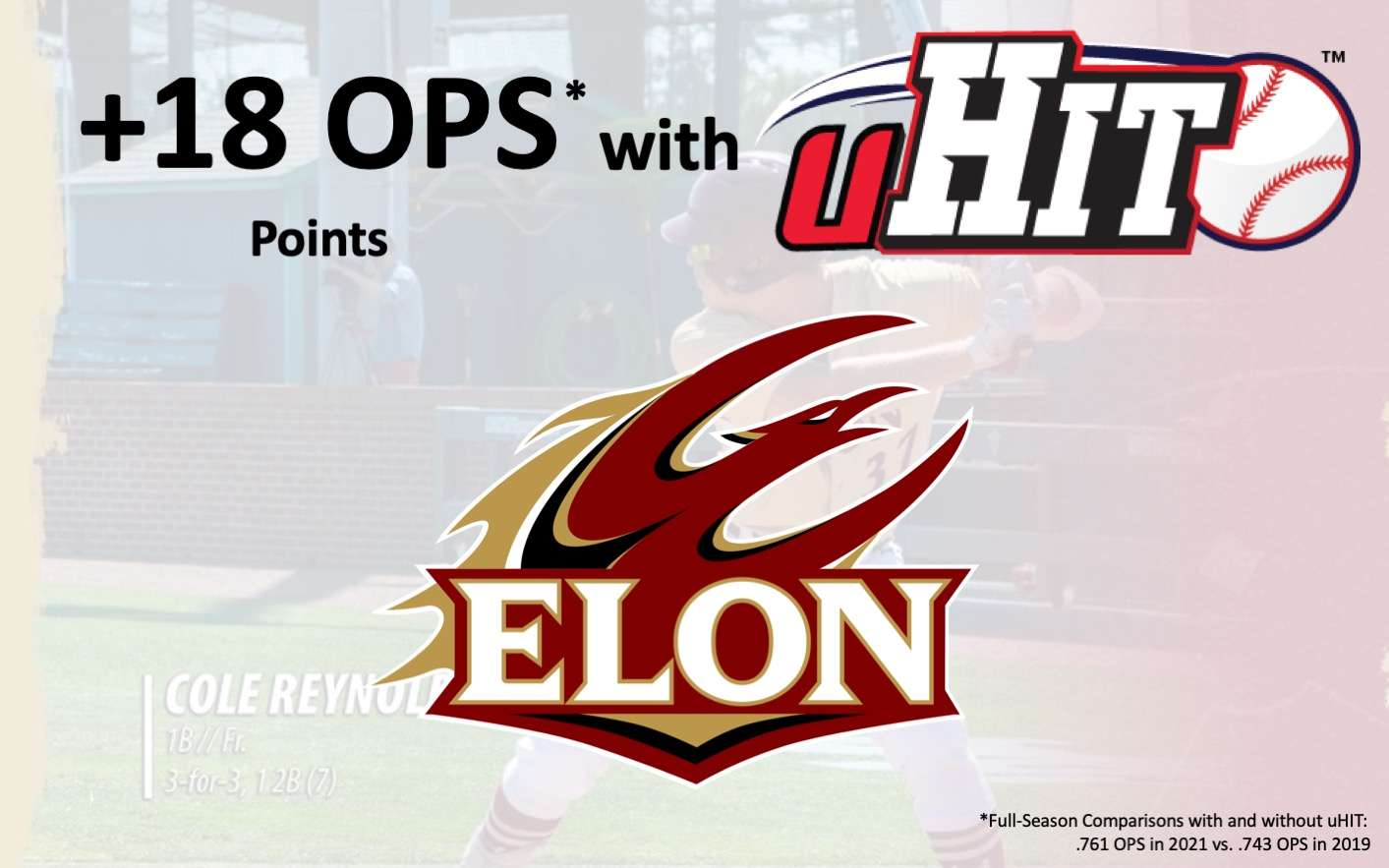Fixing Pitch Selection in D1 Baseball
Elon Baseball Case Study
5-Min Interview with Hitting Coach Shows How
July 8, 2021
Elon Baseball (D1) Raised OPS.
Above, Coach Redmond explains how.
Below, we unpack the details while they used uHIT Custom.

Elon Baseball | +18 OPS Points
The Elon Baseball team and Hitting Coach Vin Redmond also took a proactive approach in Spring 2021. Redmond successfully applied for the uHIT College Partnership Program and secured uHIT Custom Training for his hitters that spring leading into and continuing through part of the 2021 season.
Starting uHIT Custom Training just in early Spring 2021, Elon Baseball hitters racked up 8803 pitches on uHIT Custom. Prioritizing pitch recognition for his hitters, Redmond was able to get substantial buy-in from his hitters across both pitch and zone recognition programs in uHIT (measured in number of pitches worked):
-
Pitch Recognition: 6215 Pitches Worked in uHIT
-
Zone Recognition: 2588 Pitches Worked in uHIT
With Assessments done in early Spring 2021, we can see uHIT’s effects on the Elon hitters over a much shorter time span (2 months, compared to 5 months for Hartford). (Again, because of NCAA rules, we will only identify players without last names to give you a feel for how we assessed, trained and re-assessed the Elon hitters with uHIT.)
We first look at Brendan, who started his uHIT Custom experience with an Assessment of 47% Accuracy and a Reaction Time to the zone of 0.491 sec. In case you skipped from the last section, you might need a reference point for these numbers: 100% Accuracy would mean Brendan identified every pitch type perfectly, and either tapped or stopped a tap when doing so in uHIT; on Reaction Time, an optimal time to the zone from our research shows around 0.430 sec for the Assessment pitch speeds. So looking at Brendan’s numbers, he was well below the Accuracy and above the Reaction Time goals for pitch recognition.
Now, fast forward only 2 months later to the start of the Spring 2021 season, and after 813 pitches of uHIT Custom Training, Brendan is now pulling an Accuracy of 66% (a +19% change). Most importantly, he is recognizing time he has as the ball is approaching and utilizing that extra time to improve his Accuracy in pitch recognition. We can see this from his Reaction Time increasing from the training to 0.509 sec (a +0.018 sec change). Going into next season, the goal for Brendan’s hitting will be to keep increasing his Accuracy (first) to drive getting on-base and then to maintain that Accuracy, while decreasing his Reaction Time (second) to drive more power to the ball. These goals would all be automatically programmed by uHIT Custom Training program directly in the uHIT app for Brendan.
We can look at more players like Brendan to see their changes from Assessment to later Re-Assessment after Custom Training:
-
Jackson: 55% Accuracy to 72% Accuracy (1278 pitches)
-
Matthew: 55% Accuracy to 69% Accuracy (454 pitches)
-
Parker: 56% Accuracy to 69% Accuracy (252 pitches)
Extending these types of changes across the 16 other hitters of Elon, we can see where a +18 point change in OPS might have come from. Of course, not all hitters took to uHIT like these four, but the team effects are measurable in more ways than just one player at a time. To look at this more closely, we again looked back to the last full season Elon Baseball played and compared that season’s team hitting to this season’s. But we also looked at data from Elon’s proprietary point system for scoring decisions at the plate. We will start with this point system first and then come back to the OPS changes after that.
How uHIT Correlated with Elon’s Proprietary Measure of Decision-Making On-Field
The short video interview above from the uHIT Academy takes you through how Elon’s proprietary measure of decisions at the plate are calculated. The interview then shifts to how the uHIT Assessment scores correlated to these on-field measures, without any previous knowledge of how Elon was tracking decision-making on-field.
Now, switching gears to the more familiar metrics of OPS, we can see how uHIT’s Custom Training impacted on-field hitting for Elon. In 2019, Elon Baseball also had an older team than in 2021. As we know, an older team of hitters is more experienced and capable of better decision making at the plate in real games. Based on that, anyone would expect the 2021 team to have poorer decision making at the plate than the 2019 team (a similar case to what we saw with Hartford above). And these decisions should reflect in measures like on-base percentage plus slugging percentage, or “OPS” for short.
Yet, despite these differences in experience, the 2021 Elon hitters also out-performed the more experienced 2019 hitters:
-
OPS in 2019 | .743
-
OPS in 2021 | .761
When we breakdown these numbers by getting on-base (OBP) and generating power (SLG), we found that the biggest driver for Elon was also SLG. In other words, the Elon hitters of 2021 were generating more extra-base hits than those of 2019.
So again how can we explain these better hitting numbers with a less experienced and younger team of hitters in 2021? What were the new approaches or new technologies used in 2021 that were not used in 2019? That’s where we asked Coach Redmond, the Hartford Hitting Coach, for his take on things. He told us,
“We spent a lot of time talking about getting a good pitch to hit and using uHIT as a tool for that”
-Hitting Coach, Elon Baseball
In other words, Redmond saw that the addition of uHIT Custom Training was making a direct impact on pitch selection in 2021. This allowed a less experienced team of younger hitters (2021) to out-perform a team of more-experienced and seasoned hitters (2019) on the key offensive output measures like OBP plus SLG.


